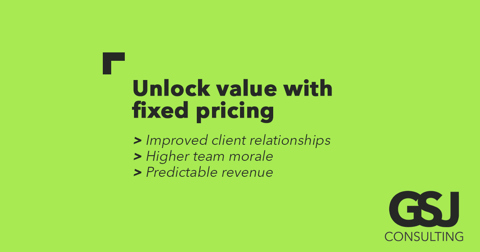A guide to moving from discounts to fixed fees

If you’re offering strategic discounts to all your clients, then they are no longer strategic: you’re simply giving money away. Worse, you’re undermining your brand, both personal and firm.
There is, however, a viable, profitable alternative: fixed fees.
Done right, transitioning your firm from constantly offering discounts (or making write-downs before you send the bill) to implementing a fixed fee structure is one that can yield tremendous financial benefits.
The following is a quick guide to help you and your firm make the transition from constantly offering discounts to a more rewarding fixed fee arrangement.
Why you should move to fixed fees
Discounts can be a powerful marketing tool to gain short-term traction, but there are pitfalls to relying on them as a long-term strategy. These pitfalls include:
- Perceived devaluation: Regular discounts may lead clients to undervalue your services, associating your worth with the lower, discounted price rather than the actual value you deliver.
- Profit erosion: Over time, consistent discounts will eat away at your profit margins, making it harder to sustain and grow your practice.
- Client expectation: If clients are used to receiving discounts, they may be reluctant to pay full price in the future.
Conversely, fixed fees communicate stability, professionalism and confidence. When you adopt a fixed fee structure, you send a message that the price reflects the true value of what you're offering, without the need for constant adjustments or reductions.
Benefits of a fixed fee structure
There are several advantages to moving to fixed fees. These include:
- Transparency: Clients know exactly what to expect, fostering a sense of trust and clarity in your business dealings.
- Value-driven sales: You can focus on selling your services based on the value you provide, rather than constantly emphasising price reductions.
- Predictable revenue: Fixed fees lead to more stable and predictable revenue streams, which is crucial for effective business planning.
- Improved client relationships: By eliminating the back-and-forth negotiations about discounts, you create a professional and straightforward interaction with clients.
- Higher team morale: Constantly having to discount away from your hourly rack-rate leads to discontent within your team, who are relying on meeting their annual budget to get their bonus. So, every time you discount their rate by 10 or 20 percent, they will have to work 10 or 20 percent extra. I’ve also never met a lawyer who enjoys the daily grind of timesheets and six-minute intervals. With fixed fees, these issues disappear.
Preparing for the transition
Switching from discounts to fixed fees requires thoughtful preparation and communication to ensure a smooth transition. Here’s how to get started.
-
Understand your value proposition
Before you can confidently set fixed fees, it's critical to understand and articulate the unique value your business provides. Ask yourself:
-
- What problems does your service solve?
- How does it improve the lives or businesses of your clients?
- What differentiates you from competitors (remembering it may be that you offer fixed fee cost certainty!)?
Conduct surveys, analyse feedback and gather testimonials to identify the aspects of your offering that clients value the most. This insight will be instrumental in justifying your fixed fee pricing.
-
Analyse your operating costs
A fixed fee model demands a thorough understanding of your operating costs. Calculate the true cost of delivering your service; including materials, labour, overheads and any other expenses. Set your fixed fees at a level that covers these costs while providing a healthy profit margin.
-
Segment your client base
Not all clients have the same needs or budgets. Consider segmenting your client base and tailoring fixed fee packages that cater to different segments.
For instance:
-
- Basic tier: Covers essential features or services at an entry-level price.
- Premium tier: Includes additional benefits or personalised services for a higher fee. In this tier, you should also include urgent turnaround requests or out-of-hours (say weekend) work.
This approach allows you to appeal to a broader audience while maintaining the integrity of your fixed fee model.
Navigating challenges
As with any significant change, moving to a fixed fee model may come with challenges.
Here’s how to tackle some common ones:
- Client resistance: Some clients may resist the change, particularly if they’ve grown accustomed to discounts. Address their concerns empathetically and reiterate the value they’re receiving. In need, introduce the new fee structure with new clients and keep the old clients on their existing fee structure until they ask for new work to be done under the new pricing structure.
- Internal buy-in: Ensure that your team understands and supports the new model. Provide training to help them confidently communicate the fixed fee structure and value proposition to clients.
- Fine-tune pricing: It may take time to find the sweet spot for your fixed fees. Monitor client feedback and market response, and be willing to adjust if necessary.
Conclusion
Once you’ve successfully transitioned to a fixed fee model, celebrate the milestone with your team. Share the success stories, highlight the benefits realised and continue to build on the foundation of value and transparency you’ve established.
By moving away from timesheets, discounts and embracing fixed fees, you position your firm as one that values its offerings and its clients. It’s a step that not only strengthens your brand but also paves the way for sustainable, profitable growth and success.
Contact GSJ Consulting
We can help you Aquire, Retain, Grow
The information contained in this article is of general nature and should not be construed as professional advice. If you require further information, advice or assistance for your specific circumstances, please contact us.
